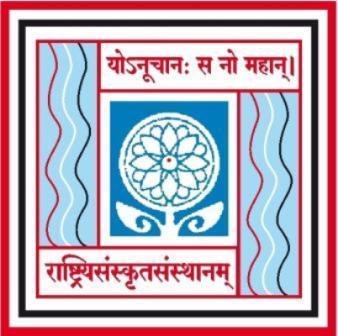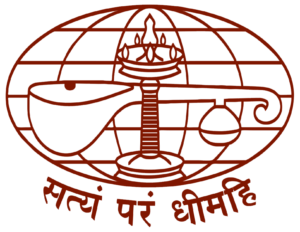CHINMAYA RESEARCH SERIES

Akhyatacandrika with the Commentary, Purnima – It is a rare ancient lexicon of synonymous Sanskrit verbs written by Bhattamalla in metric style with the commentary entitled Purnima of V. R. Manoj. The uses of synonymous verbs have been elaborated by quoting other lexicons and drawing examples from celebrated literary works. It provides derivative history of verbs wherever there is complexity. Reference to every quote is provided in the text itself for ease of access and understanding. Verses are continuously numbered for ease of access. Meanings are given in the locative case and synonymous verbs are in the subjective case, just as in the text and the commentary is complete with extensive indices. It is an invaluable reference manual for every Sanskrit learner.
| Commentator | Dr. V. R. Manoj |
| Language | Sanskrit |
| Series | Cinmaya Research Series - 1 |
| Pages | 532 |
| Year | 2011 |
| Price | Rs. 800 |
| ISBN | 978-93-80864-99-0 |
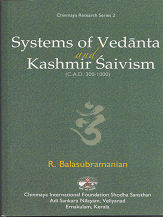
Systems of Vedanta and Kashmir Shaivism – This monograph, is an excellent overview of the essential concepts of the various schools of Vedanta as offered by its acharyas who lived during the epochal of Indian philosophy around A.D. 300 – 1000. Kashmir Shaivism, as the very name indicates, pertains to Kashmir. It is non-dualistic in approach unlike its southern counterparts, the Shaiva-siddhanta and Veera-Shaivism. It is noteworthy that the author has also taken for consideration this less known, yet sophisticated non-dualistic school of Kashmir Shaivism. Other lesser known schools of Vedanta, which we find mentioned in the vast commentary tradition such as the Bhedabheda as well as Shabdadvaita of Bhartrhari have also been briefly covered.
| Author | Prof. R. Balasubramanian |
| Gen. Editor | Dr. D. K. Rana |
| Language | English |
| Series | Chinmaya Research Series - 2 |
| Pages | 180 |
| Year | 2011 |
| Price | Rs. 225 |
| ISBN | 978-93-80864-04-4 |

Kridaniyakam -Finding the celestial beings deviating from righteousness in the Treta Yuga, Lord Brahma, the creator, had tried to bring them back to moral life but in vain. As a last resort, the Lord took four different elements from the four Vedas and created kridaniyakam, a toy which can be seen and heard, named Natyaveda. This story is detailed in sage Bharata’s Natyasastra, the ancient Indian dramaturgy. A toy involves mirth and tears. Natya which reflects the light and darkness of life is a toy. But it has the prowess to guide the human society from vices to virtues. Comedy and tragedy are integral to mankind. In the traditional Sanskrit theatre, Bhagavadajjukam and Mattavilasam are farces impregnated with philosophical anguish. This book is an analysis of these two plays culminating into the terrain of kridaniyakam.
| Author | Dr. N. K. Geetha |
| Gen. Editor | Dr. D. K. Rana |
| Language | English |
| Series | Chinmaya Research Series – 3 |
| Pages | 208 |
| Year | 2012 |
| Price | Rs. 250 |
| ISBN | 978-93-80864-09-9 |
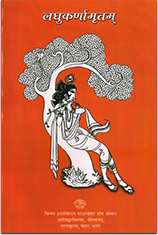
Vedic Etymology and Semantics – A Linguistic Approach – Language instils the power of creativity in human beings. It reflects in all his cultural domains. Now-a-days, linguistic studies are carried out with an interdisciplinary approach comprising of the sociological, anthropological and historical features. India, from the Vedic times, took language seriously. The Nirukta of Yaska, a unique treatise in etymological study is rich in the analytical observation on Vedic words. The study based on the Nirukta, more or less reveals the divergent areas of ancient Indian linguistic thoughts. This work is designed in six chapters. The first chapter discusses the ancient linguistic attempts of Indian scholars. In the second chapter, etymological observations of the predecessors of Yaska have been considered. Linguistic observations of Yaska exhibited in the Nirukta are the subject matter of the third chapter. Fourth chapter discusses the etymologies of Yaska with a linguistic approach. Some sociological features are examined in the fifth chapter from the etymological explanations available in the Nirukta. The last chapter evaluates the important points deliberated in the earlier chapters.
| Author | Dr. Parvathy K.P |
| Gen. Editor | Dr. D. K. Rana |
| Language | English |
| Series | Chinmaya Research Series – 4 |
| Pages | 155 |
| Year | 2012 |
| Price | Rs. 200 |
| ISBN | 978-93-80864-10-5 |
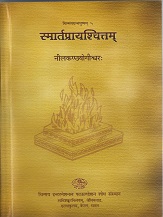
Satakotih of Mahamahopadhyaya Killimangalam Narayanan Namputiripadu -This work is a vadagrantha explaining a Paniniyasutra, Arthavadadhaturapratyayah pratipadikam to be more specific, in different angles. All the four constituent words are taken for detailed study. This sutra is discussed in Mahabhashya, Sabdendusekhara, Praudhamanora and other classical texts of grammar. But all the different views discussed here are not available in those texts. The treatment of the author is so exhaustive that nothing remains to be said further on this sutra.
| Editor | O Vatsala |
| Language | Sanskrit & English |
| Series | Chinmaya Research Series - 5 |
| Pages | 312 |
| Year | 2012 |
| Price | Rs. 250 |
| ISBN | 978-93-80864-12-9 |
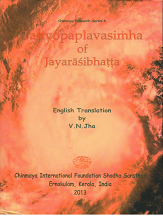
Tattvopaplavasimha of Sri Jayarasi Bhatta with English Translation -The text is often regarded as belonging to the Carvaka school, which would make it the only extant authentic text from that school. The Tattvopaplavasimha examines epistemology, where he considers the pramana (sources of knowledge) accepted in establishing conclusions (perception, inference, and testimony), and proves that none of them are sufficient for establishing knowledge. Inference relies on inductive reasoning which cannot be shown to be universal premises. Testimony requires the reliability of the witness, which must be established by another of the pramana. Even direct perception cannot establish truth, because it requires that the perception not be erroneous or illusory, which also cannot be established. Therefore, Jayarasi argues that none of the sources of knowledge are valid, and nothing can be known for certain. Jayarasi challenged the astika establishment’s belief in supernatural beings by attacking their epistemology with different arguments in Vaitandika style. Jayarasi has elaborated the different technical terminologies of philosophy used by the philosophers of that period while he establishes his own doctrines. Prof. V. N. Jha, a renowned scholar of Nyaya, Mimamsa and Vyakarana has translated it in to English on the basis of Baudhabharati, Varanasi edition, 1987 by Pt. Sukhlalji Sanghavi and Rasiklal Parikhji. It has been translated keeping silence in the place of broken Sanskrit texts in several places. This book consists of an introduction detailed analysis edition and English translation with extensive notes of the complete text and indices of all technical words used in the text.
| Translator | Prof. V. N. Jha |
| Gen. Editor | Dr. D. K. Rana |
| Language | Sanskrit & English |
| Series | Chinmaya Research Series - 6 |
| Pages | 477 |
| Year | 2013 |
| Price | Rs. 600 |
| ISBN | 978-93-80864-11-2 |
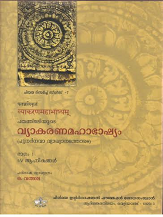
Vyakarana Mahabhasyam with the Malayalam commentary, Punarnava –
This work is the only available commentary on Patanjali’s Vyakarana Mahabhasyam in Malayalam. The present edition consists of the first five Ahnika’s of Vyakarana Mahabhashya. As the commentary is aptly titled ‘Punarnava’ by Prof. O. Vatsala, it gives forth the freshness and revelation when red in a bright light as opposed to the obscurities experienced in earlier readings because of the darkness in understanding owing to the complexity of ideas conveyed. It is true that Mahabhashyam has a ground earth simple language but the complex terms and terminologies and grammatical principles expressed in it are enough to make the text incomprehensible at times. But Prof.Vatsala’s Malayalam commentary is certainly going to guide students who follow Malayalam language, not only studying grammar but also the students of different branches of Sanskrit learning.
| Author | Prof. O. Vatsala |
| Language | Sanskrit and Malayalam |
| Series | Chinmaya Research Series- 7 |
| Pages | 508 |
| Year | 2013 |
| Price | Rs. 800 |
| ISBN | 978-93-80864-14-3 |
Navyanyayaparibhashaya pratyayarekhanganapadhatya ca prameyanirupanapranali –It is strongly recommended to undertake the study of Navya Nyaya language and the ontology of Vaiseshika for the students of any Indian shastric school, without which one cannot paraphrase a single lime of shastric monograph written in Navya Nyaya style. The basic elements of Navya Nyaya language have been dealt with in the present work. The contrast and synergy between the knowledge representation methodologies of Navya Nyaya technical language and western symbolic and mathematicl language or First Order Predicate Calculus or conceptual graphs, are introduced to the Sanskrit readers in this work. The usage of graphical representation is a speciality of this book.
| Author | Prof. Shrinivasa Varakhedi |
| Language | Sanskrit |
| Series | Chinmaya Research Series- 8 |
| Pages | 107 |
| Year | 2013 |
| Price | Rs. 200 |
| ISBN | 978-93-80864-15-0 |
Dhatunamanekarthatvasadhanam –Scholars of all branches of learning in Sanskrit oft-quote and endorse the theory of the multiple sense-ess of Sanskrit verbal roots to vouch for the specific meaning a verbal form conveys in a given context. It is natural for any language to have numerous nouns and adjectives because naming of entities and describing their qualities are not founded on grammatical propositions. Different entities may have same names and they may share similar characteristics. But verbs that describe actions should have unambiguous sense for the reason that actions have definable parameters. All other components of a sentence have definite and invariable connection to the verb and the specific action it describes. This work proposes to examine different views on this subject and would settle on the multiple senses of the roots and prop up the indicative-ness of the prefixes
| Author | V. R. Manoj |
| Language | Snaskri & English |
| Series | Chinmaya Research Series- 9 |
| Pages | 96 |
| Year | 2014 |
| Price | Rs. 200 |
| ISBN | 978-93-80864-98-3 |
Brahmaguptaganitam –The present work Brahmagupta’s Ganita contains the Sanskrit text of Ganitadhyaya of Brahmasphutasiddhanta with introduction, English translation and notes along with illustrative examples of Prithudakaswami and others. Rationale for the geometric theorems and rules are provided with relevant figures. Parallel rules and examples found in other available works on Hindu mathematics have been indicated and complete solution of the examples are given in modern notation and symbols for the benefit of the students
| Author | Venugopal D Heroor |
| Language | Sanskrit and English |
| Series | Chinmaya Research Series- 10 |
| Pages | 189 |
| Year | 2014 |
| Price | Rs. 350 |
| ISBN | 978-93-80864-19-8 |
Lilavati Vol.I-The present work provides the explanations and transliteration, in English prose order which makes sense in English translation. Some of the features of the book are: It starts with various of the methods of the eight arithmetical operations and zero as an infinitesimal. The linear equations in multiple variables, quadratic equations, combinatorials and the Rules of Three, Five, Seven, Nine and Eleven
| Author | A. B. Padmanabha Rao |
| Language | Sanskrit and English |
| Series | Chinmaya Research Series- 11 |
| Pages | 256 |
| Year | 2015 |
| Price | Rs. 380 |
| ISBN | 978-93-80864-18-1 |
Lilavati Vol.II-The present work provides the explanations along with the Sanskrit text and its translation, wherever necessary. The traditional methods are compared with modern methods. This book provides the word by word translation in English prose order which makes sense in an English translation. The word by word translation throws light on how dexterously words are used to replace the numerals and the mathematical formalism to suit the poetic form in which entire mathematics was presented. The present work gives the Sanskrit text in Devanāgarī script along with the Roman transliteration. Proofs based on Bhāskarācārya’s works in Algebra and Astronomy are provided in the Appendix.
| Author | A. B. Padmanabha Rao |
| Language | Sanskrit and English |
| Series | Chinmaya Research Series- 12 |
| Pages | 263 |
| Year | 2014 |
| Price | Rs. 380 |
| ISBN | 978-93-80864-18-1 |
Satasloki-The present work, Satasloki, is a pre-eminent one among the Prakarana granthas and is neither very short nor very long. In this work the essence of the Prasthanatraya is summarized in a very lucid manner. The style of the verses in this work is a little difficult, though very pleasing. All the topics expounded at various places in Vedanta are also found here. The special feature of the present work in English by Sri S. N. Sastri is that, along with word-by-word meaning, relevant extracts from the Upanishads, the Bhashya, etc., are given, so as to bring out the true import of the verses clearly. Because of the experience so gained, his translation of the present work Satasloki has been very successful in bringing out the true spirit of the original. There is no doubt that seekers who are not particularly proficient in Sanskrit will be greatly benefited by the study of this book.
| Author | S. N. Shastri |
| Language | Sanskrit and English |
| Series | Chinmaya Research Series- 17 |
| Pages | 157 |
| Year | 2015 |
| Price | Rs. 400 |
| ISBN | 978-93-80864-37-2 |
Mahabhashyarthadipika – Navahnikanta – Prathamo Bhaga-The present work, contains essays on the nine Ahnikas of Mahabhashya.It is not a commentary of every work and phrase in the Mahabhashya. The author has not taken all the Vartikas for comment, but only those which are supportive to the grasping of the subject. It presents the contents of Mahabhashya in simple prose for the benefit of the students and scholars.
This treatise, is an independent work based on Navahnika and is characterised by incisive, clear and in depth analysis. In writing the work, the author has used the well-tested traditional purvapaksha-siddhanta method wherein all doubts pertaining to the topic are discussed threadbare and solutions provided. It is quite possible that this treatise is but the second work, in Sanskrit, originating from Kerala pertaining to Mahabhashya
| Author | Krishna Kumar |
| Language | Sanskrit |
| Series | Chinmaya Research Series- 18 |
| Pages | 408 |
| Year | 2015 |
| Price | Rs. 500 |
| ISBN | 978-93-80864-30-3 |
MEGHASANDEáA Of KËLIDËSA
| Editor | Prof. N.P.Unni |
| Gen. Editor | Dr. Dilip Kumar Rana |
| Language | Sanskrit and English |
| Series | Chinmaya Research Series - 14 |
| Pages | 807 |
| Year | 2016 |
| Price | Rs. 1100 |
| ISBN | 978-93- 80864-25- 9 |

Sridhara’s Trisatika or Patiganitasara – Indians, in the past, as in the present, had a keen interest in Mathematics and made huge strides in the field. Sri Venugopal Heroor, an engineer by profession, has had a keen interest in Indian mathematicians. He has translated several mathematical works of Bhaskaracharya, Brahmagupta, Narayana Pandita, and Chitrabhanu into both, Kannada and English.
| Translator | Sri Venugopal Heroor |
| Language | English |
| Series | Cinmaya Research Series - 19 |
| Pages | 193 |
| Year | 2015 |
| Price | Rs. 450 |
| ISBN | 978-93-80864-20-4 |
Vishnusahasranama with Laghuvivarana of Kutallur Nilakantha –The present edition of Vishnusahasranama with Laghuvivarana or Namasahasrakarika which is critically edited based on five manuscripts. Basically, the Vivaranabhashya has been composed following to the bhashya of Sri Sankara. In the text of Laghuvivarana, (Namasahasrakarika) the author Nilakantha, a Nambutiri Brahmin of the Kutallur family has quoted the names of different bhashyakaras and commentators of Vishnusahasranama in the course of the interpretation of the namas such as – Anantanarayanavritti, Kesavavritti, Brahmendravyakhya, Sankarabhagavadbhashya and Laghuvritti.
| Editor | Dr. Dilip Kumar Rana |
| Language | Sanskrit and English |
| Series | Chinmaya Research Series |
| Pages | 254 |
| Year | 2016 |
| Price | Rs. 500 |
| ISBN | 978-93-80864-28-0 |


